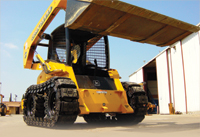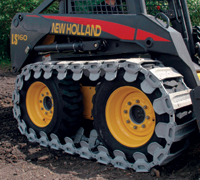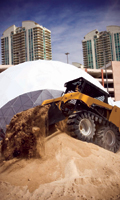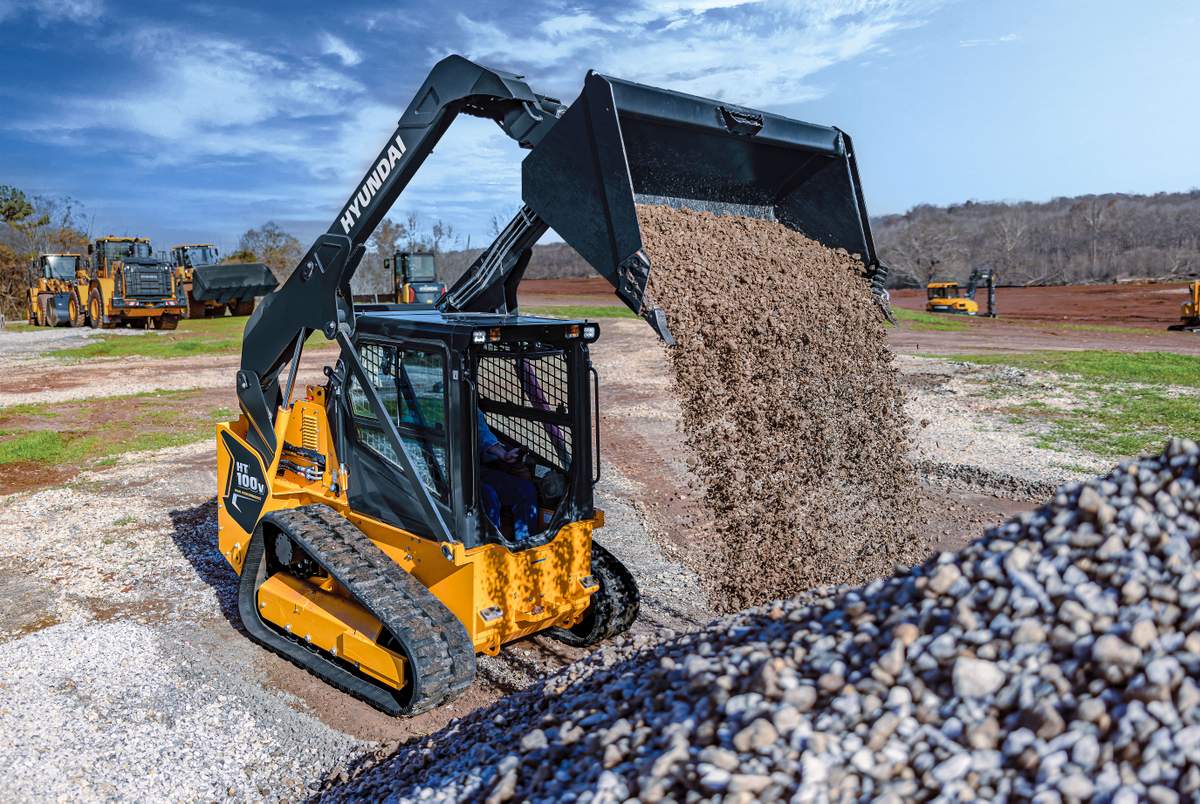Talking Tracks
 Given its low operating cost and wide variety of attachments, a skid steer can spearhead or provide backup on most jobsites in the construction and landscape industry. However in soft, soggy work conditions, the skid steer’s four wheels have a reputation for losing traction, hampering its effectiveness to move quickly, create pushing power and leave a small footprint. When extra traction and flotation is needed (especially during the wet spring season), skid steer operators can pull out a set of over-the-tire tracks (OTTs), fasten them around the tires and give their wheeled tool carrier added oomph in sloppy conditions (similar to a dedicated track loader).
Given its low operating cost and wide variety of attachments, a skid steer can spearhead or provide backup on most jobsites in the construction and landscape industry. However in soft, soggy work conditions, the skid steer’s four wheels have a reputation for losing traction, hampering its effectiveness to move quickly, create pushing power and leave a small footprint. When extra traction and flotation is needed (especially during the wet spring season), skid steer operators can pull out a set of over-the-tire tracks (OTTs), fasten them around the tires and give their wheeled tool carrier added oomph in sloppy conditions (similar to a dedicated track loader).
With tracks, operators can utilize their skid steers in situations where a track loader would work best (mud, sand and clay) and still retain the versatility of wheels when working on hard surfaces where skid steers excel (concrete, asphalt and curbs). Since over-the-tire tracks can be put on and removed easily and quickly, an operator can run his or her skid steer in a variety of applications, without having the hassle or expense of owning two different machines.
“The over-the-tire product allows operators to get more from the skid steer — using the tires on abrasive jobs and over-the-tire tracks on wet applications — getting the best of both worlds,” says Jared Steier, product manager for tracks at Solideal, a manufacturer of OTT systems.
The majority of OTTs are offered in steel or rubber designs. Steel tracks are ideal when an operator must work in harsh environments such as demolition sites, rocky soils and forest or underbrush. The steel tracks provide extra traction in applications where tires usually slip due to large or loose debris. Rubber tracks offer supreme flotation in wet or soft areas and landscaping applications, since the tracks remain in constant contact with the ground. Rubber tracks are also preferred when an operator must cross over concrete or asphalt because they will not gouge or scar the surface like steel tracks can. However, the cost of rubber tracks is generally more expensive than steel.
Track manufacturers offer a variety of OTT systems both in steel and rubber. To fully understand the usefulness of tracks, it’s important to discover the different product lines of OTT systems that each company manufactures.
Loegering’s Steel Selection
Three Different Steel Systems form the Creator of Skid Steer Tracks

For more than 30 years, the company has designed steel offerings for its skid loader customers. Today Loegering still answers the OTT call with three unique steel systems — the F-Series, Z-Series and N-Series tracks.
“OTT steel tracks provide users the opportunity to go places they typically would not be able to with a wheeled loader,” says Tim Martin, marketing manager for Loegering Mfg. “They not only give you the traction and flotation necessary to maneuver in different soil and working conditions, but they also add some ground points of contact, increasing stability and bettering the ride.”
The F-Series is a steel track design that uses steel pads to offer both traction and flotation on a wide range of applications and materials in the construction industry, explains Martin. The pads are enclosed, giving the operator extra flotation by bridging the gap between the tires. Loegering’s Z-Series is a steel bar design that concentrates on traction and aggressive terrain. Martin notes that the Z-Series tracks are beneficial to applications such as land clearing and side hill work. The track’s cross members are open for material to flow through and increase the pressure of each contact point.
The N-Series is a light-duty, low hour track that is less expensive for those customers that do not use their machines in an industrial application. Martin mentions that the N-Series is ideal for operators working on areas such as equestrian farms, poultry farms, hobby farms and residential areas.
Solideal’s Rubber Track Roundup
A Leading Manufacturer of Track Technology Delivers a Solid Rubber OTT Line
Solideal, a leader in the material handling and construction tire markets, first introduced mini excavator and compact track loader tracks into its product line in the 1990s. Shortly after, the company developed an over-the-tire track system to meet the needs of its customers with skid steers who required flotation to meet the needs of demanding projects with unique surfaces.
“With the Solideal over-the-tire track, you gain the flotation associated with a track loader, without losing the versatility of a skid steer machine,” explains Jared Steier, product manager for tracks at Solideal. “This is truly a flotation attachment that will help you get jobs done in wet or soft areas and landscaping applications.”
Solideal offers over-the-tire tracks that are made completely of rubber. They are available in 10 and 12 in. widths and will fit on all brands of standard skid steers on the market today, says Steier. The pricing of Solideal’s line ranges from $3,400 to $4,700 per set, depending on the width and length of track needed.
Solideal’s OTTs are easy to install, say company officials. The all-natural rubber track is light enough for two people to move around and install in under 30 minutes. The tracks come with an installation guide that explains how to install the tracks and retain and adjust tension. The lighter weight and easy installation is ideal for operators who wish to remove the OTT after a project, notes Steier, with the ability to install the tracks when needed and then take them off when they don’t. Steier adds that the addition of Solideal’s OTT requires minimum adjustments, since other than the need of wheel spacers no other machine modifications are required.
The lifespan of the rubber tracks depends on the application. For example, if the tracks are used in a highly aggressive or abrasive application, the tracks will wear faster than when operating on softer soils, explains Steier. In order to keep the tracks clean, they simply need to be sprayed down occasionally to avoid any mud from building up.
Grouser Goes the Distance
Dozer Expert Turned Track Designer Offers Two Main OTT Styles

After dabbling in the dozer market for skid steers, Grouser determined that the machine required extra flotation and traction to effectively utilize its pushing attachments. By 1986, Grouser had introduced two durable over-the-tire track designs into its product line — the Bar track and the EX combo track; the EX comes in two styles with steel or urethane inserts.
“Our over-the-tire tracks are a heavy-duty, industrial version,” explains Gary Luther, sales manager for Grouser. “We utilize ductile casting that’s heat treated, as well as replaceable bushings. Our linkage is heavier than other OTTs on the market and the tracks clean well.”
The Bar track, which has been Grouser’s mainstay in the OTT market for years, is an all steel, open bar design. An open bar design has an opening between the two bars on the same pad section, explains Luther. This track is ideal in soft, muddy conditions and cleans well after use since the large openings between the bars allow mud to shake and fall through, says Luther.
The initial cost of these tracks are a little lower compared to rubber tracks; a customer can expect to spend around $2,500 to 3,500 for the Grouser Bar track.
Grouser’s EX Combo track features a closed bar design that can utilize a urethane or metal insert. The closed bar design features a closed pad section that is one piece with no opening for the mud to fall through. With the ability to change and replace inserts, operators have the option to choose the material that will best fit the surface they are running over.
For example, if an operator is crossing over new concrete or asphalt, the urethane inserts are recommended. Urethane is also suggested for areas with new sod. Attach the metal inserts and work in sloppy, mud covered sites when flotation and traction are needed. The EX Combo track can cost around $3,000 to 4,000 for metal inserts and $3,000 to $5,000 for rubber inserts.
To install the track, the operator should drive the skid steer onto the track and bring the ends around so they meet right in between the tires.
“After the first mounting, the track can be installed in as little as 15 to 20 minutes,” says Luther. “Track tension is measured with a straight edge going from tire to tire, and measuring from the middle down to the track. We like to see 2 to 3 in. of sag.”
When the need to replace the inserts comes up, steel inserts range from $700 to $900 and urethane inserts run anywhere from $1,400 to $1,800 to replace.
McLaren Makes Its Mark
Steel and Rubber OTT Systems Boost Skid Steer Performance

The Protrac Series became the first skid steer track to use pins and links made of heat-treated forged chromium-enriched steel alloy — explains George Zafirov, McLaren marketing manager — featuring exceptional wear resistance, extensive track life and low-cost maintenance.
“Any skid steer loader that needs improved traction, flotation and tire protection can utilize McLaren tracks,” says Zafirov. “McLaren over-the-tire track systems improve the performance of skid steer loaders working in severe weather conditions, as well on harsh surfaces.”
The Protrac over-the-tire track system comes in three models and sizes to suit a variety of customer needs. The Protrac Diamond Series features a tire-holding base that is designed to ideally fit the skid steer loader tire, providing maximum grip without slippage, says Zafirov. The track features diamond shaped crossbars that prevent sliding of the skid steer even when working in wet and icy conditions. Depending on track size, the Protrac Diamond system costs $1,900 to $2,200.
McLaren’s Protrac Magnum is a heavy-duty track system that can handle the harshest ground conditions found at demolition, land clearing and mining sites, says Zafirov. As McLaren’s heaviest track, the Magnum system optimizes machine stability and the shoe is made of manganese-enriched steel alloy. The system can range from $3,100 to $3,400.
The Protrac Rubber is considered McLaren’s most versatile track, notes Zafirov. The track’s heavy-duty rubber shoes are reinforced with steel plates, offering durability — yet, they’re gentle enough to use on sidewalks and asphalt. The Protrac Rubber system costs $3,400 to $4,000.
For a first time installer, the installation process would take around 30 minutes and can be easily installed anywhere in the field.
“McLaren supplies an installation kit with every set of tracks, which includes all of the necessary tools to install the tracks on the machine,” says Zafirov. “In addition to the tools, the installation kit includes a detailed step-by-step installation manual.” The manual is also available for download at McLaren’s Web site, www.McLarenUSA.com.
Once the tracks are installed, Zafirov notes that the operator can use the skid steer in a similar fashion as a track loader would be used, depending on the specifics of the terrain and the application.
Depending on the make and model of the skid steer, the F- and Z-Series track sets retail from $2,000 to $3,500. The N-Series tracks cost $1,500 to $2,000.





Comments are closed here.